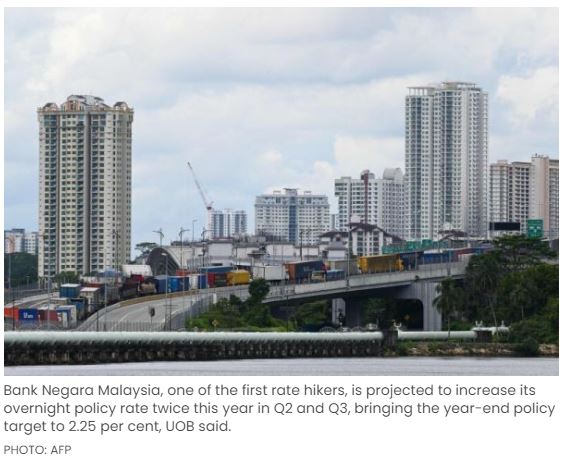Asean central banks to hike rates from end-Q2, starting with Malaysia, Philippines: UOB
UOB’s research team expects Asean central banks to start lifting off only nearer to the second half of 2022, compared to global peers who have already begun tightening rates.
In a note on Thursday (Feb 24), the team said the Bank Negara Malaysia (BNM) and Philippines’ central bank Bangko Sentral ng Pilipinas (BSP) will impose their first hikes around the end of Q2 2022, at 25 basis points (bps) each.
This will be followed by a 25 bps rate hike from the Bank of Thailand (BOT) in the third quarter, and a series of hikes by the Bank Indonesia (BI), anticipated to be the most hawkish of the 4 with an expected cumulative increase of 100 bps in H2 2022, in UOB’s view.
As a whole, the research team believes the demand-pull from the 4 economies appears to be returning gradually.
However, the bank noted overall inflation is subject to global commodity price movements and prolonged supply-related disruptions, and there is likely to be a return to the usually robust pre-pandemic level, albeit a slow one, particularly in non-essential consumption.
BNM, one of the first rate hikers, is projected to increase its overnight policy rate twice this year in Q2 and Q3, bringing the year-end policy target to 2.25 per cent, UOB said.
UOB based this on improving growth momentum, building domestic inflation pressures for the supply and demand side and a possibly more aggressive US Federal Reserve monetary policy normalisation. The increases will therefore help preserve some room between Malaysia’s overnight policy rate and the US Federal Funds rate, maintaining exchange rate stability.
Meanwhile, BSP is facing pressure to start normalising its monetary policy from rising inflation, improving domestic growth outlook and the US Federal Reserve’s tightening policy, UOB’s team said.
It has revised its BSP outlook to 3 rate hikes in 2022 at 25 bps each, up from the previous estimate of 2 hikes, bringing the reverse repo rate for the central bank to 2.75 per cent by end-2022.
“We roll out the possibility of back-to-back interest rate hikes as we believe that the BSP will carefully develop its policy normalisation plan in order not to choke off the existing growth momentum particularly when downside risks still linger,” UOB added.
As for BOT, UOB reckons it is likely to stay accommodative despite higher global interest rates, as the central bank expects inflation to range between 1-3 per cent for 2022 based on stable inflation pressures at an average of 1.2 per cent in 2021.
The bank sees BOT adding a token rate hike of 25 bps to bring its benchmark rate to 0.75 per cent in 2022 in response to the faster-than-anticipated US Federal Open Market Committee’s rate hike.
The fourth central bank, BI, is expected to deliver the “most quantum” of rate hikes in 2022, said UOB, starting with 2 25 bps hikes in Q3 and another 2 25 bps climbs in Q4 2022.
Including another pair of 25 bps increases in Q1 2023, UOB sees there being a likely terminal rate hike this round to 5 per cent.
UOB observed that domestic-driven reasons would include demand-pull inflation, which will only start showing in the latter half of this year, and the rate of rupiah’s depreciation will remain gradual as it return to its usual current account deficit, reversing the anomaly current account surplus of 0.28 per cent of gross domestic product in 2021.
Source: https://www.businesstimes.com.sg/asean-business/asean-central-banks-to-hike-rates-from-end-q2-starting-with-malaysia-philippines-uob


 Thailand
Thailand




